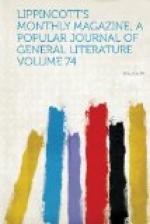* * * * *
Unless the Paris postmen are more patient than those of Madrid (who were on strike a few weeks since), their temper must be ruffled by the transformations now going on in the names of streets. In France, and especially in Paris, each overthrow of a dynasty produces a corresponding revolution in the city directory, for all unpopular names must be effaced, and the streets which bore them must be rebaptized in accordance with the political favorites of the hour. Decrees have already turned the Avenue de l’Empereur into the Avenue des Lacs; the Avenue Napoleon into the Avenue de l’Opera; the Place Napoleon into the Place de l’Opera; the Avenue de l’Imperatrice into the Avenue du Bois de Boulogne; the Boulevard Voltaire into the Boulevard de Belfort; the Rue Magnan into the Rue d’Angouleme-Saint-Honore (its old name); the Rue Billault into the Rue de l’Oratoire-du-Roule, also its old appellation; while there has been a general effacing of those names which the Communists set up upon the streets and avenues during their brief lease of power. Scores of other old names of streets are already changed or are in train of alteration; but the preceding will suffice for examples. Now, when one reflects that at the overthrow of Charles X., and again at the overthrow of Louis Philippe, and again at the overthrow of the Second Republic, and again at the overthrow of the Second Empire, and again at the overthrow of the Commune, these alterations wept on, it is seen that the puzzle offered to Paris people in general, and to Paris postmen in particular, must be anything but amusing. Should the Third Republic perish to-morrow, a new christening of streets would have to be made; but the event only would determine whether the new names should celebrate Imperialism, or Communism, or Bourbonism, or Orleanism, or each in its turn. It is rather strange that, with such an experience, Paris should not take refuge in that tame but enduring system of street nomenclature which is based on the letters of the alphabet and the ordinal numbers.




